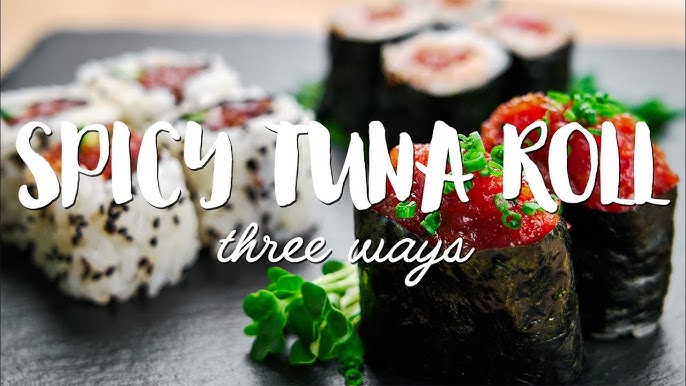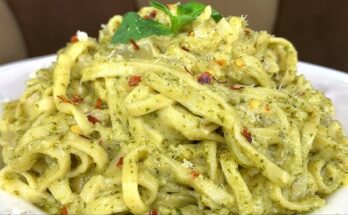Spicy Tuna Recipe: Spicy tuna is a beloved dish in Japanese cuisine, known for its bold, zesty flavor and silky texture. It’s most commonly seen in sushi rolls, like the famous spicy tuna roll, but the dish itself is so versatile that it can be used in bowls, on toast, or even as a dip. It combines raw or lightly seared tuna with a spicy, creamy sauce—usually based on mayonnaise and chili paste or sriracha.
What makes spicy tuna truly irresistible is the contrast of textures and flavors. You get the smooth, melt-in-your-mouth tuna balanced with the kick of spice and a hint of umami. The dish is not only flavorful but also incredibly satisfying and nutritious, offering a high-protein, low-carb option for those watching their diets.
Why You’ll Love This Recipe
If you’re a fan of sushi or looking for a new, exciting dish to spice up your weeknight dinners, this spicy tuna recipe is for you. It’s fast, fuss-free, and doesn’t require any advanced culinary skills. You can whip it up in under 15 minutes, making it perfect for busy schedules. The best part? You can customize it to your liking—whether you want it extra spicy, less creamy, or even vegan.
This spicy tuna recipe is not just for sushi rolls. You can enjoy it on top of rice bowls, inside lettuce wraps, or even spread over crackers for a quick snack. Plus, once you learn the basics, you can tweak the ingredients to suit your palate or dietary needs.
Ingredients You’ll Need
Fresh vs. Canned Tuna
When it comes to making spicy tuna, the quality of the tuna makes all the difference. Fresh, sushi-grade tuna is ideal. It offers a clean, buttery flavor and soft texture that’s perfect for this dish. You’ll often find sushi-grade yellowfin or bigeye tuna at Asian markets or high-end grocery stores.
However, if you’re in a pinch or looking for a more budget-friendly option, canned tuna works too. Just make sure it’s packed in water, not oil, and drain it well before using. While the flavor and texture won’t be quite as rich as fresh tuna, canned tuna still makes a delicious spicy tuna salad or sandwich spread.
Key Ingredients for the Best Flavor
Here’s what you’ll need for a basic yet delicious spicy tuna:
- 8 oz sushi-grade tuna (or 1 can of tuna, drained)
- 2 tablespoons Japanese mayonnaise (Kewpie preferred)
- 1 tablespoon sriracha or chili paste
- 1 teaspoon sesame oil
- 1 teaspoon soy sauce
- 1 teaspoon rice vinegar
- 1 green onion, finely chopped
- Toasted sesame seeds (optional, for garnish)
- Nori sheets or sushi rice (optional, for serving)
You can easily adjust the spice level by adding more or less sriracha. For an extra layer of flavor, consider adding minced garlic, a touch of wasabi, or even diced avocado. The beauty of this recipe lies in its flexibility—once you nail the base, the sky’s the limit.
Tools and Equipment
Kitchen Tools for Preparation
You don’t need fancy gadgets to make this recipe, but having the right tools can streamline the process:
- Sharp knife – for dicing the tuna finely
- Mixing bowl – for combining all your ingredients
- Cutting board – preferably a separate one for raw fish
- Measuring spoons – to keep proportions accurate
- Gloves – optional, but helpful for handling raw fish hygienically
If you’re planning to make spicy tuna rolls, having a bamboo sushi mat and plastic wrap will come in handy. For bowls or lettuce wraps, basic kitchen utensils will do just fine.
Tips for Proper Handling
When working with raw fish, cleanliness is non-negotiable. Always wash your hands and sanitize surfaces before and after handling raw tuna. If you’re using fresh fish, make sure it’s been labeled “sushi-grade” and keep it refrigerated until just before use.
Also, try to use your spicy tuna within a few hours of preparation. The fresher, the better—especially if you’re enjoying it raw. If you’re using canned tuna, it’s a bit more forgiving in terms of storage, but once mixed with mayo, it’s best consumed within a day or two.
Step-by-Step Spicy Tuna Recipe
Step 1: Choosing the Right Tuna
Choosing the right tuna is the most important step for making spicy tuna that bursts with flavor and texture. Your best bet is to get sushi-grade yellowfin or bigeye tuna from a trusted fishmonger. These types of tuna offer a mild flavor with a buttery texture that works beautifully with spicy sauces.
Look for fish with a bright, vibrant color—usually a rich pink to deep red. Avoid tuna that looks brown or dull, which may indicate it’s past its prime. If you’re using canned tuna, opt for high-quality solid white albacore packed in water. It has a firmer texture and milder taste than chunk light tuna.
Always store your fresh tuna in the coldest part of your fridge and use it the same day if possible. If you’re freezing it for later use, wrap it tightly in plastic wrap and then aluminum foil to prevent freezer burn. Allow it to thaw slowly in the refrigerator for best results.
Step 2: Preparing the Sauce
The secret to a great spicy tuna lies in the sauce—it’s where all the bold, creamy, and spicy flavors come together. In a medium bowl, combine 2 tablespoons of Japanese mayo (Kewpie gives a richer, slightly sweet flavor), 1 tablespoon of sriracha, 1 teaspoon of soy sauce, 1 teaspoon of sesame oil, and 1 teaspoon of rice vinegar.
This combination brings a perfect balance of heat, umami, and tanginess. If you prefer a little sweetness, add a tiny squirt of honey or a pinch of sugar. For an extra kick, toss in a dash of cayenne pepper or a few drops of chili oil.
Whisk all the ingredients together until smooth. You should end up with a creamy, orange-colored sauce with a silky texture. Taste it and adjust to your preference—maybe a little more heat? Or a bit more acidity? This is your chance to customize it.
Step 3: Mixing and Marinating
Once your tuna is diced into small, even cubes (about ¼ inch for sushi-style texture), gently fold it into the spicy sauce using a rubber spatula or spoon. Mix just until the tuna is well coated—don’t overmix or it may start to break apart and lose its texture.
Let the mixture sit for about 10-15 minutes in the refrigerator. This short marination time allows the flavors to meld beautifully without “cooking” the fish like citrus in ceviche would. If you’re using canned tuna, you can skip the marinating step since the flavor soaks in quickly.
For extra dimension, stir in some finely chopped green onion or chives. A small handful of diced cucumber or avocado adds freshness and crunch that balances the heat.
Step 4: Serving Options
Now for the fun part—serving your spicy tuna! This dish is incredibly versatile. Here are a few popular ways to enjoy it:
- Sushi Rolls: Spread sushi rice over a nori sheet, add a line of spicy tuna down the middle, and roll tightly with a bamboo mat. Slice into bite-sized pieces and top with sesame seeds or tobiko.
- Spicy Tuna Bowl: Serve over a bed of sushi rice with toppings like avocado, cucumber, edamame, and shredded seaweed. Drizzle with extra spicy mayo for a hearty, protein-packed bowl.
- Lettuce Wraps: Use crisp romaine or butter lettuce as a low-carb vessel. Add spicy tuna, a slice of avocado, and maybe a sprinkle of crunchy onions.
- On Crackers or Toast: Need a quick snack? Scoop spicy tuna onto rice crackers or toasted sourdough for a flavorful bite.
No matter how you serve it, make sure it’s cold and fresh. And don’t forget the chopsticks!
Pro Tips for Perfect Spicy Tuna
Flavor Enhancements
Want to level up your spicy tuna? Here are some killer add-ins:
- Wasabi Paste: Just a tiny dab adds an authentic Japanese zing.
- Chili Oil: For a deeper, smokier heat.
- Garlic Powder or Minced Garlic: Enhances the umami notes.
- Ponzu Sauce: A citrusy soy-based sauce that adds complexity.
- Pickled Ginger or Daikon Radish: For a tangy crunch that cuts through the richness.
You can also experiment with different types of chili paste, like gochujang (Korean fermented chili) for a sweet and spicy twist.
Common Mistakes to Avoid
- Using Poor Quality Tuna: Don’t skimp on the star of the show. Low-quality tuna can taste fishy and ruin the dish.
- Overmixing: Be gentle when folding the tuna into the sauce to preserve its texture.
- Overpowering with Spice: Start mild—you can always add more heat, but you can’t take it out.
- Skipping the Chill Time: Letting the mixture rest helps meld the flavors and improves the overall taste.
- Serving Warm: Always serve spicy tuna cold for the best flavor and texture.
These little tweaks can make or break your spicy tuna experience, so take your time and trust the process.
Variations of the Spicy Tuna Recipe
Spicy Tuna Roll
One of the most iconic ways to enjoy spicy tuna is in a sushi roll. If you’ve ever been to a sushi restaurant, chances are you’ve seen or tasted the spicy tuna roll—it’s a fan favorite for a reason. Making it at home is simpler than you might think.
Start by placing a sheet of nori (seaweed) on a bamboo sushi mat covered with plastic wrap. Spread a thin layer of sushi rice over the nori, leaving about an inch at the top clear. Add a line of spicy tuna along the center, then roll it up tightly using the mat.
Use a sharp knife dipped in water to slice the roll into even pieces. Garnish with sesame seeds, a dab of wasabi, or a drizzle of extra spicy mayo. If you’re feeling fancy, you can top each slice with a thin slice of avocado or jalapeño for added flair and heat.
This homemade sushi roll is perfect for date nights, parties, or just treating yourself to a restaurant-quality meal in your own kitchen.
Spicy Tuna Bowl
If you’re not in the mood for rolling sushi, a spicy tuna bowl is your go-to. This dish is basically sushi in a bowl—easy to make, highly customizable, and super satisfying. It starts with a base of warm sushi rice or cauliflower rice for a low-carb option.
Top your rice with a generous scoop of spicy tuna, then pile on your favorite toppings. Popular choices include sliced avocado, shredded carrots, diced cucumber, pickled ginger, seaweed salad, and a sprinkle of furikake or sesame seeds. Don’t forget a drizzle of soy sauce or spicy mayo for that extra punch.
The beauty of the spicy tuna bowl lies in its balance: you get the creamy tuna, crunchy veggies, fluffy rice, and all the savory, spicy notes in one hearty dish. Plus, it’s easy to prep ahead for meal planning.
Nutritional Information
Caloric Breakdown
Spicy tuna is relatively healthy, especially when made with fresh ingredients and served in moderation. Here’s a general breakdown for a serving size of 1 cup of spicy tuna (without rice):
- Calories: 220-250
- Protein: 25-30g
- Fat: 12-15g (from mayo and tuna)
- Carbohydrates: 1-3g (depending on added sauces)
Using low-fat mayo or Greek yogurt can reduce the fat content. If you’re watching your carbs, skip the rice or use lettuce wraps instead. This dish is naturally gluten-free if you use tamari instead of soy sauce.
Health Benefits of Tuna
Tuna is a nutritional powerhouse. It’s rich in lean protein, which supports muscle growth and repair, and it’s low in calories and saturated fat. It also contains high levels of omega-3 fatty acids, which promote heart and brain health.
Other benefits of tuna include:
- Rich in vitamins: B12, B6, and D
- Good source of minerals: selenium, iron, potassium
- Supports weight loss: high in protein, keeps you full
- Boosts brain function: thanks to DHA and EPA
Just be mindful of mercury levels—limit consumption to 2-3 servings per week, especially if you’re pregnant or nursing.
FAQs about Spicy Tuna Recipe
Can I use canned tuna for this recipe?
Yes! While fresh sushi-grade tuna offers the best flavor and texture, canned tuna works well too—especially for quick meals like spicy tuna salad or sandwiches. Just be sure to drain it thoroughly and use high-quality white albacore if possible.
How long can spicy tuna be stored?
Fresh spicy tuna should be consumed within 24 hours, especially if it’s made with raw fish. If you’re using canned tuna, it can be refrigerated in an airtight container for up to 3 days. Always store it cold and avoid letting it sit at room temperature for too long.
What can I serve spicy tuna with?
You’ve got tons of options: sushi rolls, rice bowls, lettuce wraps, crackers, or even cucumber slices. It pairs well with avocado, cucumber, pickled ginger, and seaweed salad. The combinations are endless!
How spicy is spicy tuna?
That depends on how much chili paste or sriracha you use. This recipe offers a medium spice level, but you can easily tone it down or turn it up to match your taste. Want it milder? Add more mayo. Want it hotter? Add more sriracha or chili oil.
Is this recipe keto-friendly?
Yes, it can be! Skip the rice and sugar, and use full-fat mayo and low-carb veggies. Serve it in lettuce wraps or as a topping on a keto-friendly salad. The tuna itself is low in carbs and high in protein, making it perfect for a keto diet.
Conclusion
Spicy tuna is more than just a sushi filling—it’s a versatile, flavorful, and satisfying dish that can be whipped up in minutes and served in countless ways. Whether you’re making sushi rolls, crafting a vibrant poke bowl, or loading up lettuce wraps, this spicy tuna recipe is sure to impress your taste buds.
The magic lies in the quality of the tuna and the bold, creamy sauce that ties it all together. With just a few ingredients and a bit of creativity, you can bring restaurant-level flavors into your kitchen without any fancy tools or techniques.
So grab your ingredients, roll up your sleeves, and get ready to make a dish that’s spicy, satisfying, and downright irresistible.



